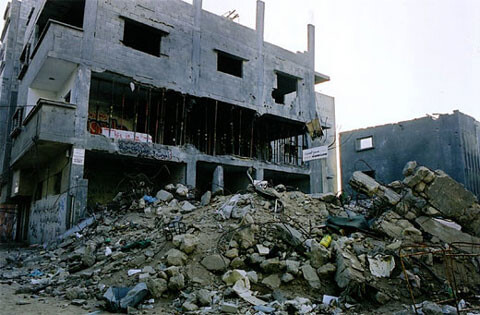Gaza Strip 8 March 2003

Above: Israeli-occupied Gaza increasingly looks like a pile of rubble. The cost in deaths and injuries in this crowded geographical area is very high. In a period slighly longer than one week some 100 Palestinians have been killed by Israeli military operations (Photo by Sam Costa).
At 8AM this morning Gaza City shook. One man just told me, “I was coming up the stairs to work. I thought the whole building was going down.” Neighbors stuck their heads from windows to see what was happening. Four US-donated Apache helicopters hung in the sky, two on each side above our heads, firing missiles directly into a car. The explosions were terrifying to an already targeted and terrorized people.
This was a targeted assassination. One of the people they murdered was a dentist working in a clinic in Gaza City’s Islamic University. He was a leader in the political wing of Hamas, Dr. Ibrahim Ahmad al-Maqadmeh.
After the Israeli military finished firing its missiles, the helicopter gun-ships hung arrogantly in the sky for 15 more minutes. No one knew if they would keep shooting. A man here tells me that they wanted to make sure they killed the people inside the car. “They waited to see if anyone would get out alive.” No one did.
Those murdered by the Israeli military this morning are, in addition to the doctor, are:
Two other people are injured. Several houses and another car were also damaged.
The night before last, the Israeli military murdered ten more people, 8 from el-Bureij Refugee Camp and two from the Namsawi area of Khan Younis. Now it’s about 100 Palestinians murdered by the Israeli military in just over a week in the Gaza Strip alone.
Gaza City’s Shifa Hospital is overflowing. There is controversy internationally as the Israeli military government denies using flechettes, made in the US and illegal under international law, packed inside its tank shells while perpetrating its massacre in the Jabalia Refugee Camp two days ago.
I’ve just been speaking with Dr. Mu’awiya Hassanain, Director General of Casualty and Emergency, Palestinian Authority Ministry of Health, Chief Surgeon of Casualty and Trauma, Vascular Surgeon in Shifa Hospital (Gaza City’s main hospital).
“I would like to say, and I would like to present, that the Israeli army is using the tank shell which is full of flechettes. Those flechettes penetrate the human body causing death by penetrating on the head, neck, chest, abdomen, and arriving to two big vessels, the aorta and femoral and its causing this due to hemeologic shock an due to hemolytic shock and other causes.I am the responsible and medical/legal doctor for all of the Intifada. I am in the position of ‘Dr. of Intifada’. I am the first one who sees and examines victims of Israelis killing and shooting of Palestinians. What I saw and what I received on the crime day, the bloody day, which was what happened in Jabalia Refugee Camp due to the using of tank shell, which is full of flechettes from the Israeli army, which caused in a few minutes death for eight Palestinian persons and injured more than 60 by the flechette and tank shell. What I would like to mention is that the flechette penetrating on the head, arriving in the brain, causing death. Its penetrating of big vessels causing severe hemorrhaging and its penetrating of the chest, localizing on the heart causing explosion for the heart and explosion for the lungs and explosion for the abdomen. All the Palestinians [in this attack] are dead due to using those flechettes.”
I visited a boy in the hospital who was injured in this attack, one standing near the firefighters as they worked in Jabalia. Both of his thighs are wrapped in thick bandages. His nose is smashed and caked with blood, trying to heal. It is difficult for families to move through the hospital because there are so many injured, the rooms and hallways are stuffed with people. I ask the doctor to show me a flechette. He holds one in his hand for me to see and says,
“I remove it from the cadaver, the body, and other shrapnel. We suffer a lot from the Israeli army.”
Kristen Ess is a political activist and freelance journalist from New York City, who has lived in the West Bank and Gaza since March 2002, where she does solidarity work and reports for Free Speech Radio news and Left Turn magazine.


